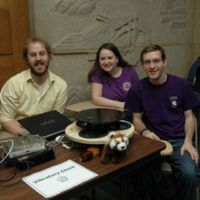Vibratory Clock
Team Members
- Jennifer Breger - Mechanical Engineering Class of 2009
- Brian Lesperance - Electrical Engineering Class of 2008
- Daniel Pinkawa - Mechanical Engineering Class of 2008
Overview
We built a horizontal circular platform that is actuated from underneath by three speakers placed in an equilateral triangle. The vibration of the platform causes a small object (e.g., an IC socket or a coin) to act as an hour "hand" on top of the platform. The object slides around the circular platform, impelled by friction forces due to the vibration. By placing the speakers at different phases and amplitudes, we got the objects to move to desired positions. Due to the nodes created by the speaker vibrations, the object will move back to the correct hour if it is moved away. Our project was given to us by Professor Colgate and was based upon the research of Professor Lynch.
Mechanical Design
The Vibratory clock consists of a wooden base, held up by adjustable legs, three speakers, and a circular platform. The following material were used to create the design:
Base:
- wood: 16" diameter, 0.75" thick
- holes: 6" diameter (3 total)
- adjustable legs: 3 rods: 3/8"-16; 4" long; 6 nuts total
Speakers:
- 3 Pyramid Power PW677X: 300W, 4 Ohms, 6.5" Chrome Subwoofer
- previously adapted speakers replaced center of speaker with attachments 3" in height
- 1/2" diameter PVC used to attach previous attachment to platform with a screw
- centers placed 7.125" apart
Circular Platform
- PVC/Acrylic: 11.75" diameter
- machined on LaserJet
- screw holes counter-sunk at 7.125" apart
